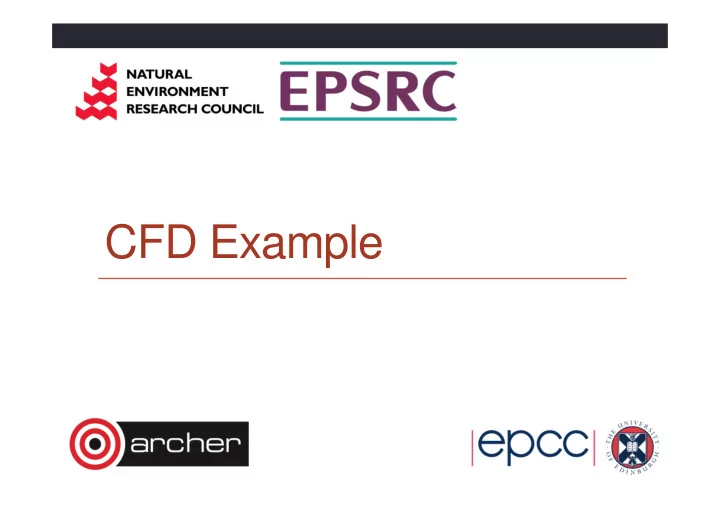

CFD Example
Aims To familiarise yourself with factors that affect code • performance compiler implementation and platform • compiler optimisation options • hyper-threading on ARCHER • process placement • parallel scaling • number of processors • problem size •
Fluid Dynamics The study of the mechanics of fluid flow, liquids and gases in • motion. Commonly requires HPC. • Continuous systems typically described by partial differential • equations. For a computer to simulate these systems, these equations must • be discretised onto a grid. One such discretisation approach is the finite difference method . • This method states that the value at any point in the grid is some • combination of the neighbouring points
The Problem Determining the flow pattern of a fluid in a cavity • – a square box – inlet on one side – outlet on the other The Cavity For simplicity, assuming zero viscosity. •
The Maths In two dimensions, easiest to work with the stream function • At zero viscosity, satisfies: • With finite difference form: • Jacobi Method can be used to find solutions: • With boundary values fixed, stream function can be calculated for each • point in the grid by averaging the value at that point with its four nearest neighbours. Process continues until the algorithm converges on a solution which • stays unchanged by the averaging.
The Maths In order to obtain the flow pattern of the fluid in the cavity we want to • compute the velocity field: The and components are related to the stream function by: • General approach is therefore: • Calculate the stream function. • Use this to calculate the two dimensions of the velocity. •
Parallel Programming – Grids Both stages involve calculating the value at each grid point by combining it with • the value of its neighbours. Same amount of work needed to calculate each grid point – ideal for the • regular domain decomposition approach. Grid is broken up into smaller grids for • each processor.
Parallel Programming – Halo Swapping Points on the edge of a grid present a challenge. Required data is • shipped to a remote processor. Processes must therefore communicate. Solution is for processor grid to have a boundary layer on adjoining sides. • Layer is not writable by the local process. • Updated by another process which in turn will have a boundary updated • by the local process. Layer is generally known as a halo and the inter-process communication • which ensures their data is correct and up to date is a halo swap .
Characterising Performance Speed up ( S) is how much faster the parallel version runs compared to a • non-parallel version. Efficiency ( E) is how effectively the available processing power is being • used. Where: • number of processors • time taken on 1 processor • time taken on N processors •
Compiling and Running the Practical A tar file is provided with • a Fortran CFD code • example job scripts • a Makefile for use with any PrgEnv module • You should: • 1 st Practical (Efficient compilation) • add optimisation flags to the Makefile, recompile and re-compare • compare different compilers • vary the number of processes • change the number of iterations and scale factor • 2 nd Practical (Using the Intel Ivy-Bridge CPU) • experiment with hyper-threading on/off • spread processes between NUMA regions • vary the number of processes • change the number of iterations and scale factor • See the exercise sheet for full details! •
Recommend
More recommend